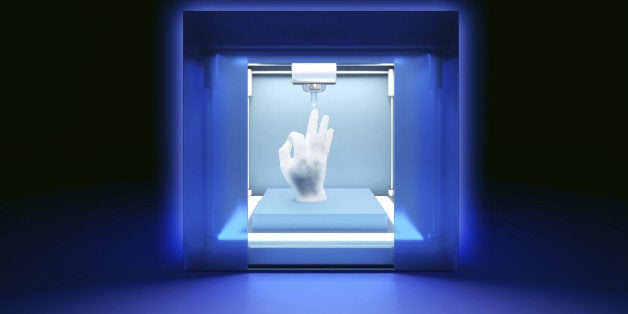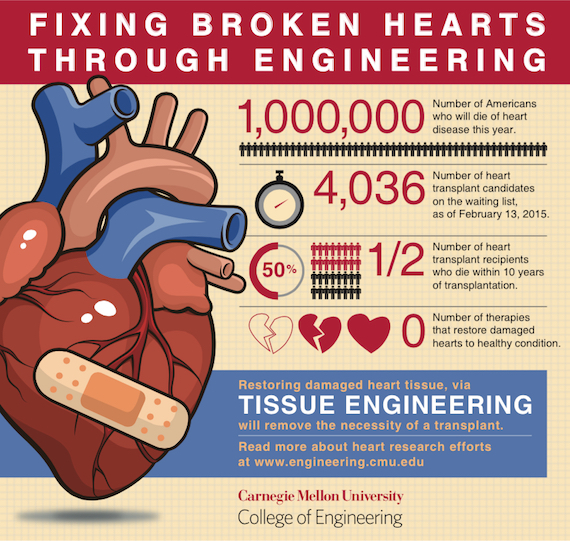
While it's difficult for me to criticize something as complex and impressive as the human heart (it pumps up to 2,000 gallons of blood through your body every day, after all), it's clear that to help manage cardiovascular disease, it could use some assistance. Since it can't repair itself like some other body parts, trauma to the heart results in tissue death, which can eventually lead to heart failure. Is there a solution to this? With today's new technologies, will it possible for mankind to actually engineer a better heart?
Last week, my post "Can Science and Technology Fix a Broken Heart?" started a conversation between myself (a practicing cardiologist) and Dr. Adam Feinberg (a leading biomedical engineer at Carnegie Mellon University's College of Engineering). In this week's post, our conversation continues, and we'll outline some of the exciting developments that are on the horizon for heart treatment.
Q: Dr. Feinberg, you recently received a $500,000 grant from the National Science Foundation for a bioprinting project that you're working on. What is bioprinting, and how does this impact heart engineering?
A: Bioprinting is the medical world's utilization of what's proven to be a revolutionary method of manufacturing: 3D printing. 3D printing is really unique because it completely changes the way we build things. It enables us to build a structure layer-by-layer; think of it like stacking sheets of paper to create a thicker 3D object. With this approach you can create incredibly complex structures in 3D, which is potentially game-changing for tissue engineering because organs like the heart are so intricate and difficult to replicate. However, to date, it has been extremely difficult to 3D bioprint soft materials such as cells and collagen at high resolution.
Q: Why has it been so difficult?
A: The challenge is that soft materials, think about something like Jell-O, will collapse under their own weight in air if they have a lot of complicated internal structure. Think about most tissues and organs: they have blood vessels and other internal cavities. We need to be able to recreate these for tissue engineering.
Q: So can you explain how you will you use the technology for tissue engineering?
A: We are developing news ways to temporarily support soft gels while we are 3D printing them, and then remove the temporary supports to leave the 3D bioprinted part behind. There is a lot of fundamental biology, chemistry, physics, and engineering required to actually do this well, and this is what NSF is funding.
We will then use this to 3D bioprint a first generation of heart muscle in the lab as initial proof-of-concept of the approach. But I'll point out that this is a long way off from being translatable to patients. This is a five-year grant and we are just getting started. There will still be years of development after that.
Q: What are the next steps in making this vision a reality in the operating room?
A: We are still a good distance from the operating room. We need more people working in this space, and we need innovative collaborations between physicians (like yourself), scientists, and engineers to accelerate development. This is one reason we're using open-source software and hardware in our approach. This will make it relatively inexpensive for other researchers to implement what we have done and build upon it. Even after we see a breakthrough, it will need rigorous testing and FDA approval before it can be used in hospitals.
Meanwhile, it's important to note that 3D printing is already making a valuable impact in the operating room in terms of surgical planning. It is now common for surgeons to take CT and MRI data and 3D print anatomical models prior to operating in order to plan what needs to be done.
Q: In your eyes, what's most exciting about the research you're working on?
A: We're constantly learning! It's not uncommon for my students to write a computer program, build a machine, synthesize new materials, culture cells, measure protein expression and then image what they engineered using 3D microscopes. This interdisciplinary approach is exciting because it leads to new discoveries.
It's truly amazing to see new technologies like 3D printing already starting to improve how we treat the human heart, and even more interesting to learn about what the future holds. With innovative research like Dr. Feinberg's, we may finally be able to engineer a better heart. You can look forward to reading more about the progress of Dr. Feinberg's heart-related projects in upcoming posts!
My book, Your Vibrant Heart, includes many more insights about how to nurture and care for your heart on both a physical and emotional level. I am currently providing a free electronic download of my best selling book, Your Vibrant Heart. Click here for the download. You can also purchase a physical copy on Amazon.
For more by Dr. Cynthia Thaik, click here.
For more by Dr. Cynthia Thaik on her website, click here.
Follow Dr. Cynthia Thaik on Twitter: www.twitter.com/DrCynthiaMD
Follow Dr. Cynthia Thaik on Facebook: https://www.facebook.com/DrCynthiaMD
